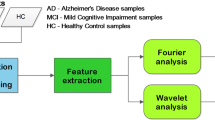Abstract
Alzheimer disease is one of the most common and fastest growing neurodegenerative diseases in the western countries. Development of different biomarkers tools are key issues for diagnosis of Alzheimer disease and its progression, in early stages. Electroencephalogram (EEG) signal analysis can be well suited for automated diagnosis of Alzheimer’s disease. This paper focuses on spectral and wavelet features for diagnosis of Alzheimer using EEG signals with effective increase in diagnostic accuracy for improvement in diagnosis in early stage. The use of spectral and wavelet based features are proposed in this paper, with effective increase in classification accuracy by use of supervised classifiers giving 94% diagnostic accuracy for early Alzheimer’s diagnosis. As compared to MRI, PET based diagnosis; the EEG based method of diagnosis of Alzheimer disease is much more cost effective. Frequency bump modeling is used to observe the effect of early stage diagnosis of Alzheimer disease using EEG. This research work of Alzheimer disease using EEG signals, explores new tool in the form of bump modeling of EEG signals; for Alzheimer disease diagnosis in early stages.



Similar content being viewed by others
References
Mattson M (2004) Pathways towards and away from Alzheimer’s disease. Nature 430:631–639
Meek PD, McKeithan K, Shumock GT (1998) Economics considerations of Alzheimer’s disease. J Pharmacother 18:68–73
Van der Hiele K, Vein AA, Reijntjes RH, Westendorp RG, Bollen EL, van Buchem MA, van Dijk JG, Middelkoop HA (2007) EEG correlates in the spectrum of cognitive decline. J Clin Neurophysiol 118(9):1931–1939
Chiang H-S, Pao S-C (2016) An EEG-based fuzzy probability model for early diagnosis of Alzheimer’s Disease. Springer J Med Syst 40(5):1–9
Silverman D (2009) PET in the Evaluation of Alzheimer’s disease and related disorders. Springer, New York
Horvath A, Szucs A, Csukly G, Sakovics A, Stefanics G, Kamondi A (2018) EEG and ERP biomarkers of Alzheimer’s disease: a critical review. Front Biosci (Landmark Ed) 23:183–220
Crosson B, Ford A, McGregor KM, Meinzer M, Cheshkov S, Li X (2010) Functional imaging and related techniques: an introduction for rehabilitation researchers. J Rehabil Res Dev 47(2):7–31
Simpraga S, Alvarez-Jimenez R, Mansvelder HD, Van Gerven JMA, Groeneveld GJ, Poil S-S, Linkenkaer-Hansen K (2017) EEG machine learning for accurate detection of cholinergic intervention and Alzheimer’s disease. Sci Rep 7(5775):1–11
Ruiz-Gómez SJ, Gómez C, Poza J, Gutiérrez-Tobal GC, Tola-Arribas MA, Cano M, Hornero R (2018) Automated multiclass classification of spontaneous EEG activity in Alzheimer’s Disease and mild cognitive impairment. Entropy 20(1)35:1–15
Wan J, Zhang Z, Rao BD, Fang S, Yan J, Saykin AJ, Shen L (2014) Identifying the neuroanatomical basis of cognitive impairment in Alzheimer’s disease by correlation and nonlinearity-aware sparse Bayesian learning. IEEE Trans Med Imaging 33(7):1475–1487
Kulkarni N (2018) Use of complexity based features in diagnosis of mild Alzheimer disease using EEG signals. Int J Inf Technol 10(1):59–64
Czigler B, Csikos D, Hidasi Z, Anna Gaal Z, Csibri E, Kiss E, Salacz P, Molnar M (2008) Quantitative EEG in early Alzheimer’s disease patients power spectrum and complexity features. Int J Psychophysiol 68(1):75–80
Daubechies (2008) Ten lectures on wavelets. Society for Industrial and Applied Mathematics, Philadelphia
Jeong J (2004) EEG dynamics in patients with Alzheimer’s disease. J Clin Neurophysiol 15(7):1490–1505
Dauwels J, Srinivasan K, Ramasubba Reddy M, Musha T, Vialatte F-B, Latchoumane C, Jeong J, Cichocki (2011) A slowing and loss of complexity in Alzheimer’s EEG: two sides of the same coin? Int J Alzheimers Dis 539621
Kang Y, Escudero J, Shin Dae (2015) Principal dynamic mode analysis of EEG data for assisting the diagnosis of Alzheimer’s Disease. IEEE J Transl Eng Health Med 3:1–10
Staudinger T, Polikar R (2011) Analysis of complexity based EEG features for diagnosis of Alzheimer Disease. In: Proc Intl Conf IEEE-EMBC, Boston, USA, pp 2033–2036
Ghorbanian P, Devilbiss DM, Verma A, Bernstein A, Hess T, Simon AJ, Ashra H (2013) Identification of resting and active state EEG features Of Alzheimer’s disease using discrete wavelet transform. Ann Biomed Eng 41(6):1243–1257
Vialatte F, Sole-Casals J, Dauwels J, Maurice M, Cichocki A (2009) Bump time-frequency toolbox: a toolbox for time–frequency oscillatory bursts extraction in electrophysiological signals. BMC Neurosci 10.1:46:1–12
Dai Z, Yan C (2012) Discriminative analysis of early Alzheimer Disease using multi-modal imaging and multilevel characterization with multi-classifier (M3). J Neuroimage Elsevier 59(3):2187–2195
Rueda A, Gonzalez FA (2014) Extracting salient brain patterns for imaging based classification of neurodegenerative diseases. IEEE Trans Med Imaging 33(6):1262–1274
Dauwels J, Vialatte Fr, Cichocki A (2010) Diagnosis of Alzheimer’s disease from EEG signals: where are we standing? Curr Alzheimer Res 7(6):487–505
De Bock T, Das S, Mohsin M (2010) Early detection of Alzheimer’s Disease using nonlinear analysis of EEG via Tsallis entropy. IEEE Biomed Sci Eng Conf 1–4
Cassani R, Falk TH, Fraga FJ, Kanda PAM, Anghinah R (2014) The effects of automated artifact removal algorithms on electroencephalography-based Alzheimer’s disease diagnosis. Front Aging Neurosci 6:1–13
Ahmadlou M, Adeli H (2010) Wavelet-synchronization methodology: a new approach for EEG based diagnosis of ADHD. Clin EEG Neurosci 41(1):1–10
Fattouh A (2016) An emotional model based on wavelet coherence analysis of EEG recordings, BIJIT-BVICAM’s. Int J Inf Technol 8(2):1023–1028
Acknowledgements
The author would like to thank the S P Pune University, India for financially supporting this work under BCUD research Grant (15ENG000865) for researchers and the Sinhgad General Hospital, Pune for their valuable help and support. The author would like to thank all authors of the references which have been used, as well as reviewers of the paper.
Author information
Authors and Affiliations
Corresponding author
Rights and permissions
About this article
Cite this article
Bairagi, V. EEG signal analysis for early diagnosis of Alzheimer disease using spectral and wavelet based features. Int. j. inf. tecnol. 10, 403–412 (2018). https://doi.org/10.1007/s41870-018-0165-5
Received:
Accepted:
Published:
Issue Date:
DOI: https://doi.org/10.1007/s41870-018-0165-5




